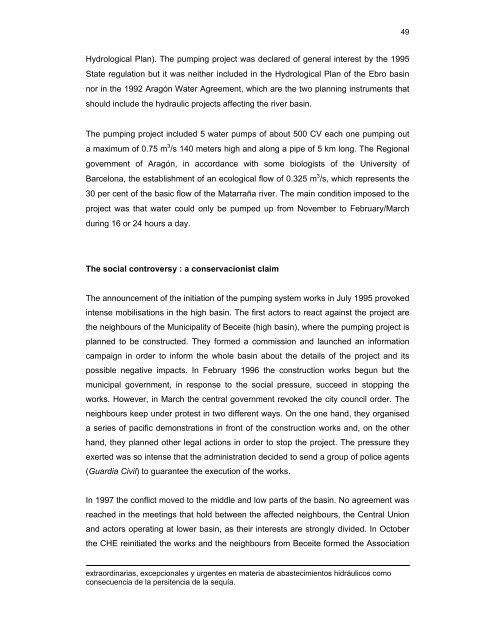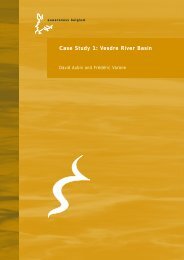Case Study 1: Matarraña River Basin - Euwareness
Case Study 1: Matarraña River Basin - Euwareness
Case Study 1: Matarraña River Basin - Euwareness
Create successful ePaper yourself
Turn your PDF publications into a flip-book with our unique Google optimized e-Paper software.
Hydrological Plan). The pumping project was declared of general interest by the 1995<br />
State regulation but it was neither included in the Hydrological Plan of the Ebro basin<br />
nor in the 1992 Aragón Water Agreement, which are the two planning instruments that<br />
should include the hydraulic projects affecting the river basin.<br />
The pumping project included 5 water pumps of about 500 CV each one pumping out<br />
a maximum of 0.75 m 3 /s 140 meters high and along a pipe of 5 km long. The Regional<br />
government of Aragón, in accordance with some biologists of the University of<br />
Barcelona, the establishment of an ecological flow of 0.325 m 3 /s, which represents the<br />
30 per cent of the basic flow of the <strong>Matarraña</strong> river. The main condition imposed to the<br />
project was that water could only be pumped up from November to February/March<br />
during 16 or 24 hours a day.<br />
The social controversy : a conservacionist claim<br />
The announcement of the initiation of the pumping system works in July 1995 provoked<br />
intense mobilisations in the high basin. The first actors to react against the project are<br />
the neighbours of the Municipality of Beceite (high basin), where the pumping project is<br />
planned to be constructed. They formed a commission and launched an information<br />
campaign in order to inform the whole basin about the details of the project and its<br />
possible negative impacts. In February 1996 the construction works begun but the<br />
municipal government, in response to the social pressure, succeed in stopping the<br />
works. However, in March the central government revoked the city council order. The<br />
neighbours keep under protest in two different ways. On the one hand, they organised<br />
a series of pacific demonstrations in front of the construction works and, on the other<br />
hand, they planned other legal actions in order to stop the project. The pressure they<br />
exerted was so intense that the administration decided to send a group of police agents<br />
(Guardia Civil) to guarantee the execution of the works.<br />
In 1997 the conflict moved to the middle and low parts of the basin. No agreement was<br />
reached in the meetings that hold between the affected neighbours, the Central Union<br />
and actors operating at lower basin, as their interests are strongly divided. In October<br />
the CHE reinitiated the works and the neighbours from Beceite formed the Association<br />
extraordinarias, excepcionales y urgentes en materia de abastecimientos hidráulicos como<br />
consecuencia de la persitencia de la sequía.<br />
49



